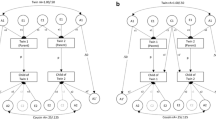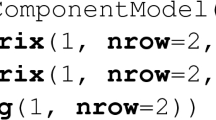Abstract
Constrained optimization recently has been implemented in the LISREL software package, allowing formulation of parent-offspring transmission models in a simple and efficient manner. A reverse path model of parental transmission is described within the LISREL framework for application to twin and/or adoptive family data. The model incorporates genetic and environmental parameter constraints arising from assortative mating and cultural transmission. An illustration of the LISREL model is given using measures obtained from twins and parents involving fear of social cirticism.
Similar content being viewed by others
References
Coon, H., Carey, G., and Fulker, D. W. (1990). A simple method of model fitting for adoption data.Behav. Genet. 20:385–404.
Eaves, L. J., Last, K. A., Young, P. A., and Martin, N. G. (1978). Model-fitting approaches to the analysis of human behaviour.Heredity 41:249–320.
Eaves, L. J., Eysenck, H. J., and Martin, N. G. (1989a).Genes, Culture, and Personality: An Empirical Approach, Academic Press, New York.
Eaves, L. J., Fulker, D. W. and Heath, A. C. (1989b). The effects of social homogamy and culatural inheritance on the covariances of twins and their parents: A LISREL model.Behav. Genet. 19:113–122.
Fisher, R. A. (1918). The correlations between relatives on the supposition of Mendelian inheritance.Trans. Roy. Soc. Edinburgh 52:399–433.
Fulker, D. W. (1982). Extensions of the classical twin method. In Bonné-Tamir, B., Cohen, T., and Goodman, R.M. (eds.),Human Genetics, Part A: The Unfolding Genome, Alan R. Liss, New York, pp. 395–406.
Fulker, D. W. (1988). Path analysis of genetic and cultural transmission in human behavior. In Weir, B. S., Eisen, E. J., Goodman, M. M., and Namkoong, G. (eds.),Proceedings of the Second International Conference on Quantitative Genetics, Sinauer, Sunderland, MA, pp. 318–340.
Fulker, D. W. and DeFries, J. C. (1983). Genetic and environmental transmission in the Colorado Adoption Project: Path analysis.Br. J. Math. Stat. Psychol. 36:175–188.
Geer, J. H. (1965). The development of a scale to measure fear.Behav. Res. Ther. 3:45–53.
Heath, A. C., and Eaves, L. J. (1985). Resolving the effects of phenotype and social background on mate selection.Behav. Genet. 15:15–30.
Jencks, C. (1972).Inequality: A Reassessment of the Effects of Family and Schooling in America, Basic Books, New York.
Jöreskog, K. G. (1971). Simultaneous factor analysis in several populations.Psychometrika 57:409–426.
Jöreskog, K. G., and Sörbom, D. (1988).PRELIS: A Preprocessor for LISREL, Scientific Software, Mooresville, IN.
Jöreskog, K. G., and Sörhom, D. (1989).LISREL 7: A Guide to the Program and Applications, 2nd ed., SPSS Inc. Chicago.
Jöreskog, K. G., and Sörbom, D. (1990). New features in LISREL 8. (manuscript in preparation).
Li C. C. (1975).Path Analysis: A Primer, Boxwood Press, Pacific Grove, CA.
Neale, M. C., and Fulker, D. W. (1984). A bivariate path analysis of fear data on twins and their parents.Acta Genet. Med. Genellol. 33:273–286.
Phillips, K., and Fulker, D. W. (1989). Quantitative genetic analysis of longitudinal trends in adoption designs with application to IQ in the Colorado Adoption Project.Behav. Genet. 19:621–658.
Rose, R. J., and Ditto, W. B. (1983). A developmental-genetic analysis of common fears from early adolescence to early childhood.Child Dev. 54:361–368.
Wright, S. (1921). Systems of mating.Genetics 6:111–173.
Wright, S. (1968).Evolution and the Genetics of Populations. Vol. 1. Genetic and Biometric Foundations, University of Chicago Press, Chicago.
Young, P. A., Eaves, L. J., and Eysenck, H. J. (1980). Intergenerational stability and change in the causes of variation in personality.Personal. Indiv. Diff. 1:35–55.
Author information
Authors and Affiliations
Additional information
An earlier version of this paper was described at the Third International Workshop on Twin Methodology in Boulder, Colorado, July 23–27, 1990. The paper was written while the first author was supported by Training Grant HD-07289 from the National Institute of Child Health and Human Development (NICHD) and by a grant from the John D. and Catherine T. MacArthur Foundation. Model development was supported in part by NICHD Research Grant HD-10333 and by research grant (MH-43899) from the National Institute of Mental Health. Preparation of the manuscript was facilitated by Grant RR-07013 awarded to the University of Colorado by the Biomedical Research Support Grant Program, Division of Research Resources, National Institutes of Health. Analyses of the data were facilitated by the BRSG grant RR-07013-25 awarded to the University of Colorado by the Biomedical Research Support Grant Program, Division of Research Resources, National Institutes of Health.
The model was developed using a beta-test version of LISREL 8. The LISREL 8 package is tentatively scheduled for commercial release in Summer 1992.
Rights and permissions
About this article
Cite this article
Cardon, L.R., Fulker, D.W. & Jöreskog, K.G. A LISREL 8 model with constrained parameters for twin and adoptive families. Behav Genet 21, 327–350 (1991). https://doi.org/10.1007/BF01065971
Received:
Accepted:
Issue Date:
DOI: https://doi.org/10.1007/BF01065971




